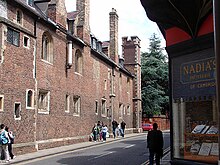
Pembroke College is a constituent college of the University of Cambridge, England. The college is the third-oldest college of the university and has over 700 students and fellows. It is one of the university's larger colleges, with buildings from almost every century since its founding, as well as extensive gardens. Its members are termed "Valencians". The college's current master is Chris Smith, Baron Smith of Finsbury.
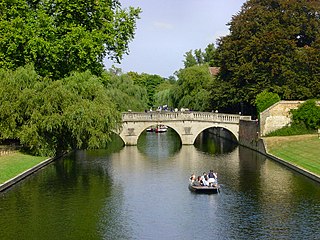
The River Cam is the main river flowing through Cambridge in eastern England. After leaving Cambridge, it flows north and east before joining the River Great Ouse to the south of Ely, at Pope's Corner. The total distance from Cambridge to the sea is about 40 mi (64 km) and is navigable for punts, small boats, and rowing craft. The Great Ouse also connects to England's canal system via the Middle Level Navigations and the River Nene. In total, the Cam runs for around 69 kilometres (43 mi) from its furthest source to its confluence with the Great Ouse.

Darwin College is a constituent college of the University of Cambridge. Founded on 28 July 1964, Darwin was Cambridge University's first graduate-only college, and also the first to admit both men and women. The college is named after one of the university's most famous families and alumni, that of Charles Darwin. The Darwin family previously owned some of the land, Newnham Grange, on which the college now stands.

Sir George Howard Darwin, was an English barrister and astronomer, the second son and fifth child of Charles Darwin and Emma Darwin.
Gwendolen Mary "Gwen" Raverat, was an English wood engraver who was a founder member of the Society of Wood Engravers. Her memoir Period Piece was published in 1952.

Henry Fawcett was a British academic, statesman and economist.

Newnham is a suburb of the city of Cambridge in England. Historically, the name refers to a hamlet centred on a mill on the River Cam, a short distance to the southwest of the city centre. The modern council ward of Newnham covers much of the west of the city. Several Cambridge University colleges are situated in this ward, including Newnham, Wolfson, Robinson, Selwyn and Darwin. In modern times Newnham has become one of the most affluent areas of Cambridge and sometimes features in national quality of life surveys.
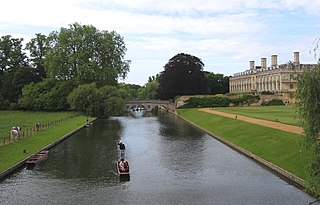
The Backs is a picturesque area to the east of Queen's Road in the city of Cambridge, England, where several colleges of the University of Cambridge back on to the River Cam with their grounds covering both banks of the river.

Period Piece: A Cambridge Childhood is a 1952 autobiographical memoir by the English wood engraver Gwen Raverat covering her childhood in late 19th-century Cambridge society. The book includes anecdotes about and illustrations of many of her extended family.

Trumpington is a village to the south of Cambridge, in the Cambridge district, in the county of Cambridgeshire, England. The village is an electoral ward of the City of Cambridge and a ward of South Cambridgeshire District Council. The 2011 Census recorded the ward's population as 8,034.
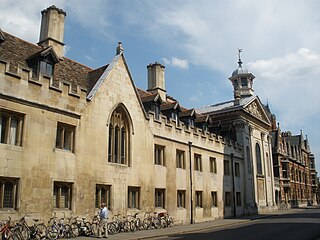
Trumpington Street is a major historic street in central Cambridge, England. At the north end it continues as King's Parade where King's College is located. To the south it continues as Trumpington Road, an arterial route out of Cambridge, at the junction with Lensfield Road.

Pembroke Street is a street in central Cambridge, England. It runs between Downing Street and Tennis Court Road at the eastern end and a junction with Trumpington Street at the western end. It continues west on the other side of Trumpington Street as Mill Lane.

Trinity Lane is a street in the centre of Cambridge, England that passes through portions of the University of Cambridge, one of the world's most prestigious universities. The lane leads off Trinity Street.

Queen's Road is a major road to the west of central Cambridge, England. It links with Madingley Road and Northampton Street to the north and with Sidgwick Avenue, Newnham Road and Silver Street to the south.

The Old Addenbrooke's Site is a site owned by the University of Cambridge in the south of central Cambridge, England. It is located on the block formed by Fitzwilliam Street to the north, Tennis Court Road to the east, Lensfield Road to the south, and Trumpington Street to the west.

Coe Fen is a semi-rural meadowland area to the east of the River Cam in the south of the city of Cambridge, England. It lies at the back of Peterhouse to the north, the Fitzwilliam Museum, and The Leys School to the south. The fen is straddled by the Fen Causeway across the Cam. There is also a footbridge at the back of The Leys School to the south and Crusoe Bridge is just north of the Fen Causeway Bridge.
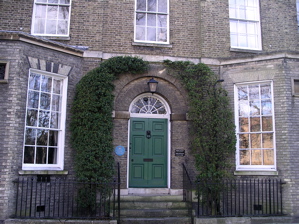
Newnham Grange is a Grade II listed house on Silver Street, Cambridge, next to the River Cam and The Backs. Since 1962 it has been part of Darwin College, Cambridge.

Martha Haskins, Lady Darwin, known as Maud Darwin, was an American socialite and the wife of the English Cambridge University astronomer Sir George Darwin.
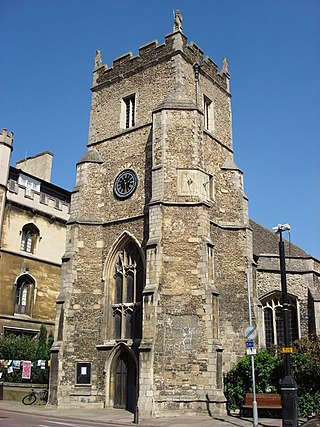
St Botolph's Church, Cambridge is a Church of England parish church in the city of Cambridge, England. The church is a Grade I listed building.
